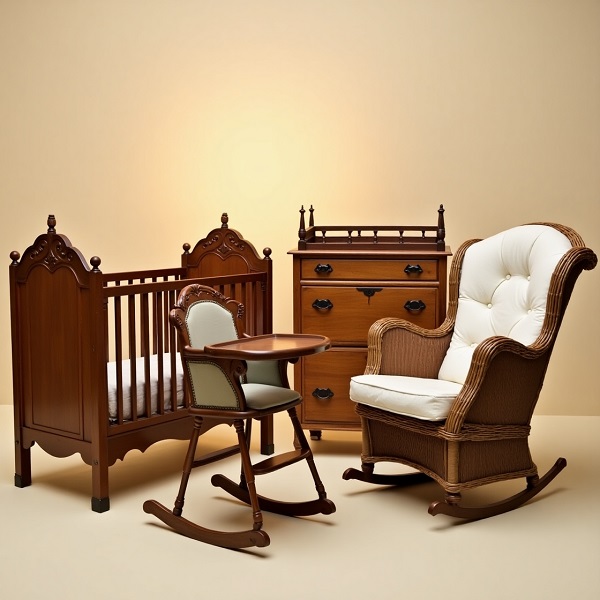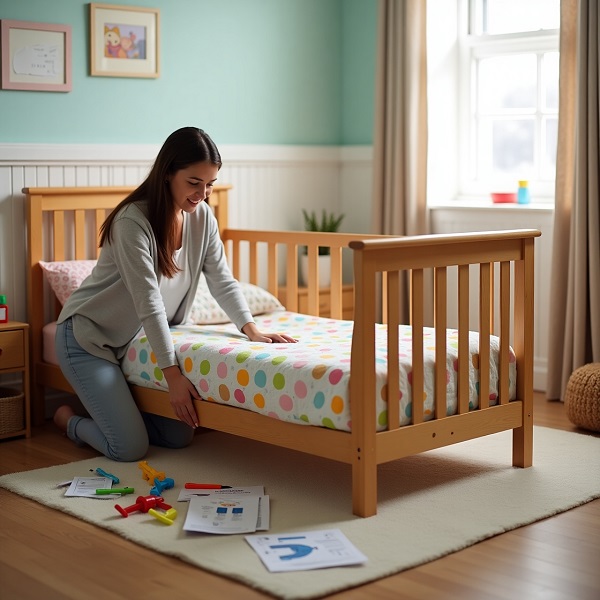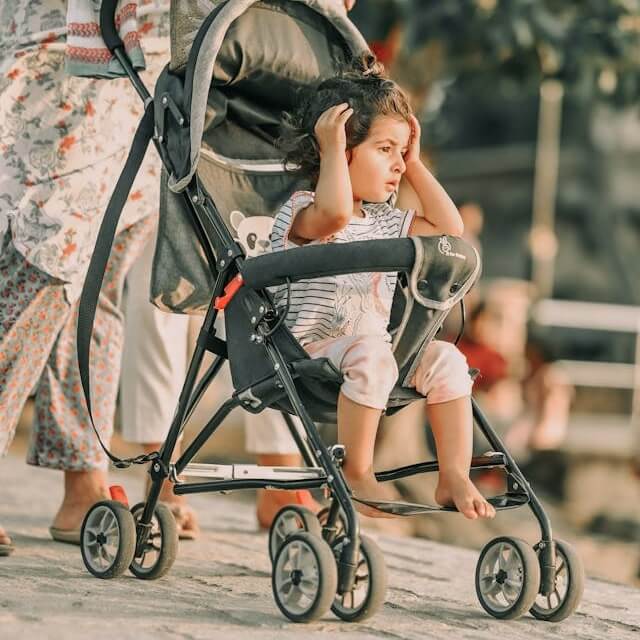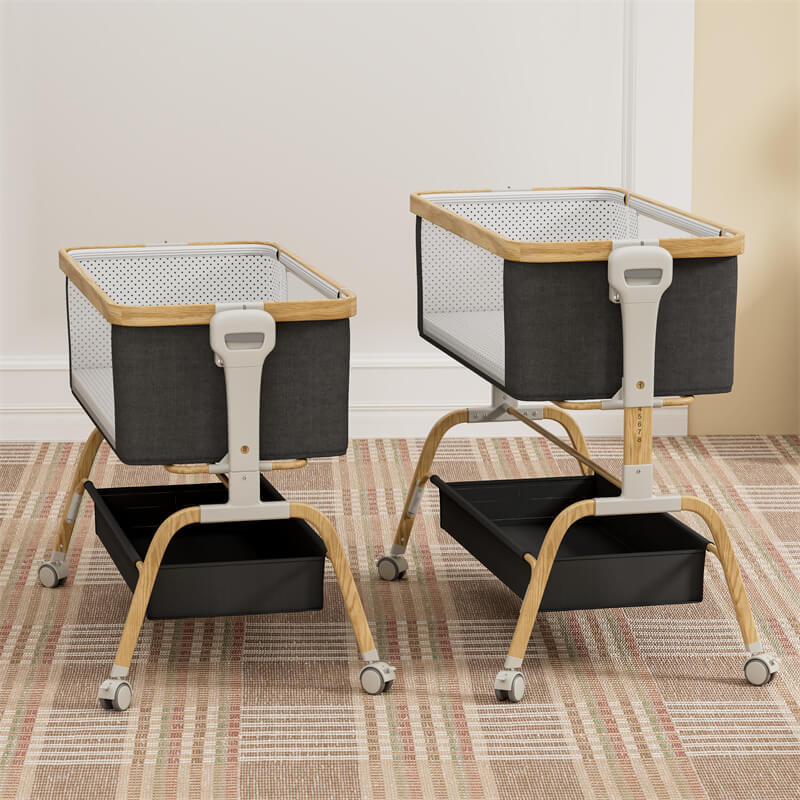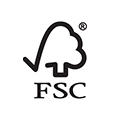The average family spends over $1,200 on baby furniture in their child’s first year alone, according to a 2022 report by the National Retail Federation. Yet many of these carefully chosen cribs, dressers, and rockers will be used for just 2-3 years before being relegated to attics or landfills. This reality has sparked a growing movement among practical parents: the second-hand nursery.
Here’s the uncomfortable truth: The CPSC reports that nearly 15,000 children are injured by nursery products each year, many involving second-hand furniture that no longer meets safety standards. A 2019 CPSC study revealed that 60% of recalled children’s products remain in use, frequently resold online.
This presents a dilemma for eco-conscious parents. That charming vintage crib from a neighborhood swap meet? It could have lead paint or unsafe slat spacing. The gently used stroller, priced at half its retail value? Its crash-test integrity might be compromised.
In the next sections, we’ll decode exactly which items are worth sourcing second-hand, which should always be bought new, and how to spot hidden dangers that even seasoned parents miss.
What Are the Potential Risks of Used Baby Furniture?
Safety Recalls That Go Unnoticed
Every year, the CPSC recalls dozens of baby products—from cribs with dangerous slat spacing to dressers prone to tipping. A seemingly sturdy crib from a garage sale could be a deathtrap if it were part of a years-old recall that was never addressed.
In fact, in 2019, the CPSC issued a recall of over 11 million baby cribs, bassinets, and play yards due to safety hazards such as structural failure or toxic chemicals.
Outdated Safety Standards
One of the biggest concerns with second-hand baby furniture is that it may not meet current safety regulations. Over the years, safety guidelines for baby furniture have evolved significantly. If a crib was manufactured before these updates, it might look perfectly fine, but it could pose a serious threat to your child.
In 2011, the CPSC implemented new crib safety standards to reduce the risk of infant suffocation and strangulation. These regulations include stricter guidelines on slat spacing, sturdiness, and the use of non-toxic materials. For instance, drop-side cribs—once popular for their convenience—were banned in 2011 due to suffocation and entrapment risks.
Missing or Lost Parts
For example, many cribs come with removable pieces like mattress support bars or safety brackets. If these parts are lost or missing, the furniture may not function properly or could be unsafe to use. Replacing these parts might not always be straightforward, and some manufacturers no longer offer replacement parts for older models.
Even if replacements are available, they may not fit correctly, creating new hazards.
Hidden Hazards in Materials and Finishes
Older pieces may contain lead paint, especially if they were made before 1978. (The U.S. banned lead in household paints in 1978.)
Similarly, some older furniture may contain toxic chemicals such as phthalates or formaldehyde, which are commonly found in certain plastics, wood finishes, and foam cushions. Although these chemicals are now heavily regulated, older furniture may still contain hazardous substances.
Potential for Hidden Damage or Mold
Mattresses and upholstered items can accumulate dust mites, mold, or even bed bugs if stored improperly. Unfortunately, mold may not always be visible to the naked eye, but exposure can lead to respiratory problems, allergic reactions, and other health complications.
Which Baby Furniture Items Are Safest to Buy Second-Hand?
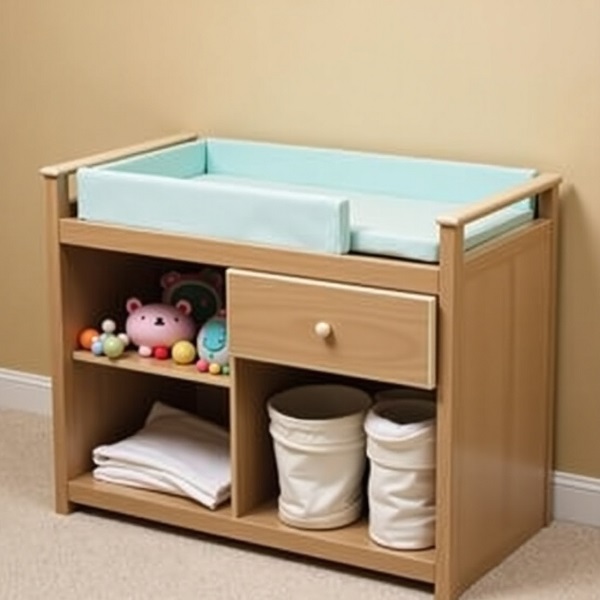
Not all second-hand baby furniture is equally safe to buy. The key is to focus on certain types of furniture that are generally more durable and less likely to have safety issues, even after years of use. These include:
- Changing tables
- Rocking chairs and gliders
- Bookshelves and storage units
- Dressers and wardrobes
Why are these types of second-hand baby furniture relatively safer?
Simpler Design and Fewer Complex Safety Features
The safest second-hand pieces typically feature simple, non-mechanical designs that eliminate complex failure points.
Unlike items with moving parts or adjustable components, static furniture, such as solid wood dressers or bookshelves, maintains its integrity over time because it doesn’t rely on hinges, latches, or folding mechanisms that can wear out unpredictably.
On the other hand, items like changing tables or rocking chairs don’t have the same complex mechanisms or safety features. For example, a changing table only requires a flat, stable surface—its primary function is to provide a safe space for diapering.
Durable Materials and Construction
Another reason why these second-hand baby furniture items are safer is that they are often made from durable materials that stand the test of time.
For example, many changing tables, dressers, and bookshelves are constructed from solid wood. These materials are not only more durable but also handle typical wear and tear better than cheaper, flimsy options. A well-made oak dresser from the 1990s frequently proves safer than a new particleboard version.
Lower Risk of Hidden Damage
Furniture that does not undergo heavy stress—such as changing tables or bookshelves—tends to be less prone to hidden damage compared to items like cribs or high chairs. Cribs, in particular, are subject to constant wear due to the frequent movement of the baby, whether it’s rocking, bouncing, or jumping as they grow.
Items like rocking chairs or dressers, however, have fewer points of mechanical failure. Rocking chairs may experience some wear on the gliding mechanism, but this is typically easy to inspect and fix. Similarly, dressers and bookshelves are primarily static and only undergo minimal stress, usually in the form of drawer opening and closing.
Fewer Components at Risk
Many baby furniture pieces, such as cribs and high chairs, include small parts like screws, brackets, and safety locks that can wear out, break, or be lost over time.
For example, a missing safety lock on a high chair or a malfunctioning slat in a crib can create significant risks for a baby. This is particularly concerning in second-hand furniture, as it can be difficult to know whether all necessary parts are intact or if replacements are still available.
In contrast, items like changing tables and dressers typically have fewer small components. Similarly, rocking chairs and gliders often have simple mechanisms that are easy to inspect for issues.
Unchanged Safety Standards
When considering used nursery items, one of the most reliable safety indicators is whether the product’s fundamental design requirements have remained consistent over the decades.
Unlike cribs, rocking chairs, dressers, and changing tables have not undergone major safety redesigns in recent years. Moreover, their basic design also hasn’t changed dramatically in terms of safety standards.
Which Baby Furniture Should You Avoid Buying Used?
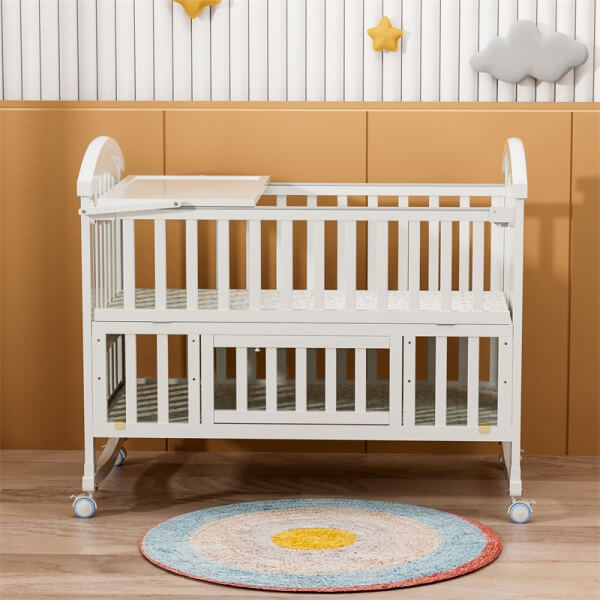
Cribs
Cribs are the most important piece of furniture in a nursery, and they directly affect your baby’s safety during sleep. Unfortunately, they are also one of the riskiest second-hand purchases due to outdated safety standards and potential structural issues. Crib safety regulations have greatly evolved over the years to address new and emerging risks.
Since infants spend 12-15 hours a day in their cribs during the first year, skimping on safety here is never worth the potential savings.
Car Seats
Car seat safety technology evolves quickly, with ongoing improvements in side-impact protection, harness systems, and energy-absorbing materials. More importantly, all car seats have expiration dates—typically six to ten years after manufacture—because the plastics degrade over time, losing their ability to protect in a crash.
High Chairs
While high chairs may appear in good condition at first glance, they often lack the updated safety features present in newer models. For instance, many older high chairs don’t come with the secure five-point harness system that is now standard in modern designs.
Some models may also lack a reliable tray-locking mechanism, which can lead to the tray detaching or shifting unexpectedly, causing potential accidents.
Playpens and Play Yards
Playpens and play yards offer a safe space for your baby to play or nap, but when bought second-hand, they can present significant risks. These items are subjected to a lot of wear, and with frequent folding and unfolding, the frames can weaken over time. This can create instability, increasing the risk of the playpen collapsing or tipping over.
How to Inspect Second-Hand Baby Furniture Before Buying?
Check for Recalls Immediately
Thousands of baby products are recalled each year due to safety hazards, but many remain in circulation. A quick search on the Consumer Product Safety Commission (CPSC) website or the manufacturer’s database can reveal whether the item has been flagged for dangerous defects.
Check for Structural Integrity
Begin by gently shaking or applying pressure to various parts of the furniture—like the legs, frame, or back—to check for any looseness, wobbling, or instability.
For cribs, ensure all slats are securely fastened and that none are missing or damaged. Similarly, for items like changing tables or dressers, make sure all joints are secure and that there are no signs of warping, cracking, or splintering wood.
Inspect for Missing or Damaged Parts
Cribs, for example, often come with specific parts like mattress supports or hardware that are essential for safe use. If you’re purchasing a second-hand high chair, ensure that all safety features, such as the harness or footrest, are intact and fully functional.
For furniture like playpens or changing tables, verify that no critical components are missing or damaged. For example, some playpens have special locking mechanisms or safety latches that prevent the frame from collapsing.
Check for Non-Toxic Materials
Since babies are highly sensitive to chemicals, it’s crucial to ensure that second-hand baby furniture hasn’t been exposed to harmful, toxic materials like lead, phthalates, or formaldehyde.
When inspecting wooden furniture like cribs or changing tables, ask the seller about the materials used in the furniture. If you don’t have this information, be cautious of older pieces.
For upholstered furniture, check the labels to ensure that the fabric is free from flame retardants or other chemicals that could pose a health risk to your baby.
Where to Buy Reliable Second-Hand Baby Furniture?
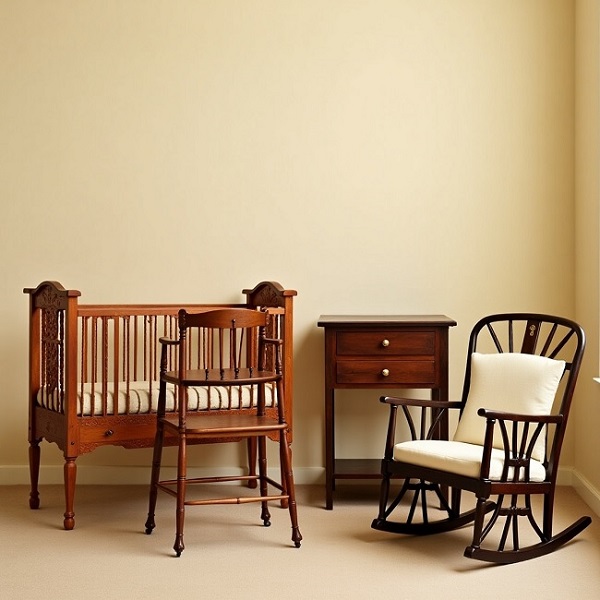
Reputable Second-Hand Stores or Online Marketplaces: Platforms like Facebook Marketplace, Craigslist, and OfferUp are great for finding used baby furniture locally. Specialized sites like ThredUp and Kidizen often offer gently used or like-new items vetted for quality.
Local Consignment Shops: These shops offer curated selections of checked items, often higher-end, gently used furniture at a fraction of the cost of new pieces.
Baby Gear Stores with Used Sections: Some baby gear stores now offer used or refurbished sections alongside their new products. These stores often have a more rigorous vetting process for used items, as they may specialize in baby gear and furniture.
Thrift Stores or Charitable Organizations: Thrift stores like Goodwill or Salvation Army can offer affordable second-hand baby furniture, though they may not have strict vetting processes, so inspection is crucial.
Baby Gear Rentals or Subscription Services: Services like BabyQuip or Rent the Baby Gear allow you to rent quality baby furniture for a limited time, ideal for short-term needs.
Community Groups and Parenting Networks: Local parenting forums, Facebook groups, or Nextdoor are great places to buy or share used baby items. Since these transactions are local, you also have the benefit of inspecting the furniture in person before making the purchase.
How to Clean and Sanitize Used Baby Furniture?
Before cleaning, take a moment to thoroughly inspect the furniture. You don’t want to spend time sanitizing something that’s beyond repair or unsafe. Examine the piece for structural damage like cracks, splinters, or wobbly joints that cleaning won’t fix.
For hard surfaces like wood, plastic, and metal, begin with a wash using warm, soapy water. Pay special attention to crevices and joints where grime accumulates. A simple guideline is to use a natural mixture of water and white vinegar, or a baby-safe disinfectant. Always rinse afterward to remove residue.
Fabric components require special care. Removable covers can be washed in hot water, while fixed fabrics are best treated with steam cleaning to eliminate dust mites and bacteria. For stubborn odors, baking soda works wonders when left overnight before vacuuming.
Some risks require extra attention. Older furniture may contain lead paint – test kits provide peace of mind. Rusty hardware should be replaced or treated. Any piece that can’t be thoroughly cleaned or repaired, especially items like crib mattresses that come into prolonged contact with your baby, should be replaced rather than risked.
Once sanitized, consider personalizing your find. A fresh coat of non-toxic paint can completely transform a piece. Replacing hardware like drawer pulls adds a custom touch.
Despite our best efforts, some pieces aren’t worth salvaging. Drop-side cribs, furniture with structural damage, or items that retain odors after cleaning should be passed over. Your baby’s safety always comes first.
Conclusion
As we’ve explored, buying second-hand baby furniture can be both a practical and rewarding choice—when done thoughtfully.
By focusing on sturdy, well-made pieces with simple designs—like solid wood dressers, bookshelves, and gliders—you can furnish your nursery beautifully without compromising on safety.
Remember, the best second-hand finds are those you can inspect, clean, and trust completely. Whether you’re motivated by budget, sustainability, or simply love the charm of pre-loved pieces, making informed decisions helps you create a safe and welcoming space for your little one.
Recommended Related Articles:

